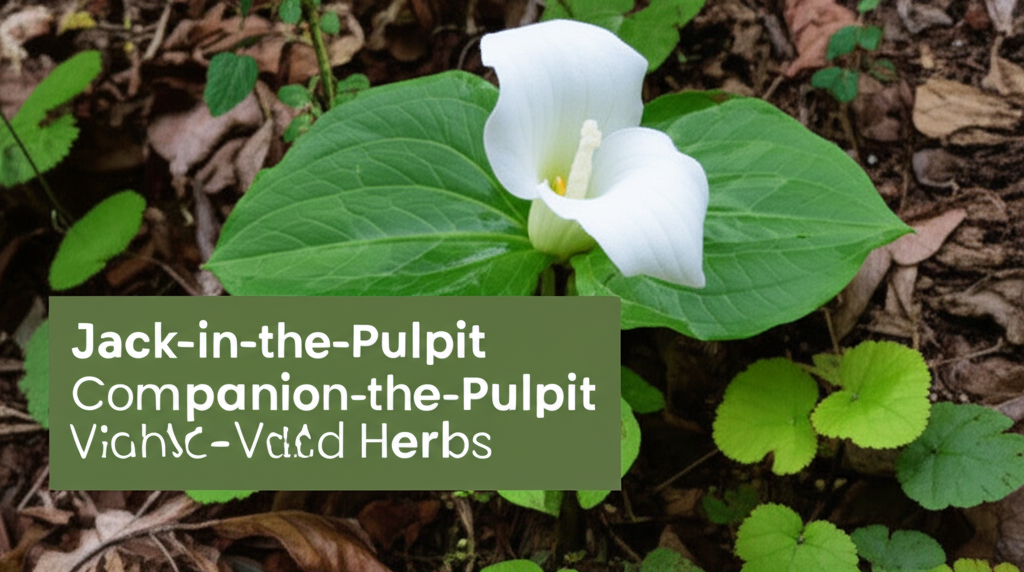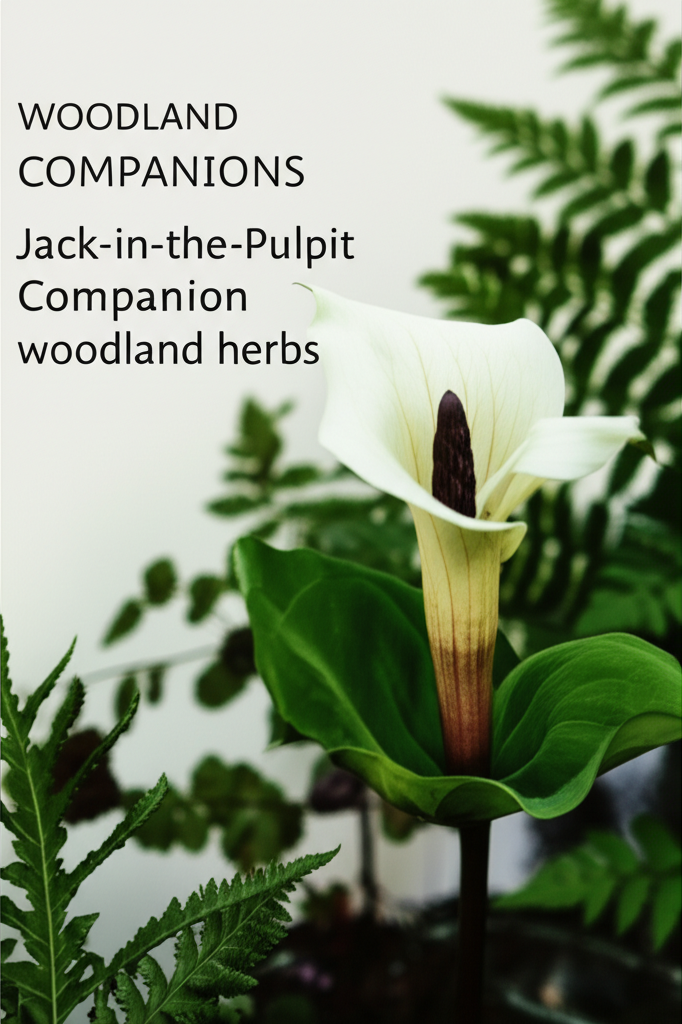Introduction: The Enchanting Jack-in-the-Pulpit and Its Woodland Allies
The Jack-in-the-Pulpit (Arisaema triphyllum) is a beloved native wildflower, instantly recognizable by its unique hooded spathe and spadix, resembling a preacher in his pulpit. Thriving in the dappled shade and moist conditions of deciduous woodlands, this fascinating perennial is more than just a beautiful specimen; it’s a key player in a thriving woodland ecosystem. For gardeners seeking to recreate this natural beauty, understanding the principles of companion planting with Jack-in-the-Pulpit and other woodland herbs unlocks a world of ecological benefits, pest deterrence, and enhanced plant health.
Companion planting is an age-old gardening technique rooted in observing natural symbiotic relationships. By strategically placing different plant species together, gardeners can create a more resilient, productive, and aesthetically pleasing garden. When it comes to woodland gardens, this practice is particularly effective, as it mimics the layered and diverse communities found in native forests. This article delves into the art of companion planting with Jack-in-the-Pulpit, exploring its ideal woodland herb companions and the multifaceted advantages they offer.
Understanding Jack-in-the-Pulpit: Needs and Characteristics

Before diving into companion planting, it’s crucial to understand the specific needs of Jack-in-the-Pulpit to ensure successful integration into your garden.
Preferred Habitat and Soil Conditions
Jack-in-the-Pulpit is a woodland ephemeral, meaning it flourishes in environments that mimic its natural habitat:
- Shade: It thrives in partial to full shade, particularly under the canopy of deciduous trees that provide filtered sunlight.
- Moisture: Consistent moisture is essential. It prefers moist, well-drained soil rich in organic matter. Avoid waterlogged conditions, which can lead to root rot.
- Soil pH: Slightly acidic to neutral soil (pH 5.5-7.0) is ideal.
- Nutrient Richness: A loamy soil with plenty of compost or leaf mold provides the necessary nutrients for healthy growth.
Growth Cycle and Dormancy
Understanding its growth cycle is key to companion planting. Jack-in-the-Pulpit emerges in spring, typically after the soil has warmed. The distinctive flower emerges, followed by a cluster of bright red berries in late summer or early autumn. The plant then goes dormant, with the foliage dying back completely in late fall or early winter. This dormancy period means that companion plants can occupy the space without competition during the colder months.
The Principles of Companion Planting in a Woodland Setting
Companion planting leverages several natural interactions to benefit the garden:
- Pest Deterrence: Certain plants release volatile organic compounds (VOCs) that repel insect pests.
- Attracting Beneficial Insects: Other plants attract predatory insects or pollinators that are beneficial to the garden.
- Nutrient Cycling: Some plants can improve soil fertility by fixing nitrogen or accessing nutrients from deeper soil layers.
- Ground Cover and Moisture Retention: Low-growing plants can help suppress weeds, retain soil moisture, and prevent erosion.
- Maximizing Space: Utilizing different plant heights and growth habits allows for more efficient use of garden space.
Key Facts: Jack-in-the-Pulpit and Woodland Herb Companions
Here’s a comparison of Jack-in-the-Pulpit with some of its ideal woodland herb companions:
| Plant | Scientific Name | Shade Tolerance | Moisture Needs | Soil Preference | Height (Mature) | Primary Benefit |
|---|---|---|---|---|---|---|
| Jack-in-the-Pulpit | Arisaema triphyllum | Partial to Full Shade | Moist, well-drained | Rich, loamy, slightly acidic | 1-3 feet | Unique aesthetic, larval host for a few moth species |
| Wild Ginger | Asarum canadense | Partial to Full Shade | Moist, well-drained | Rich, humusy, slightly acidic | 4-6 inches | Excellent ground cover, suppresses weeds, attracts beneficials |
| Foamflower | Tiarella cordifolia | Partial to Full Shade | Moist, well-drained | Rich, humusy, acidic | 6-12 inches | Attractive spring blooms, good ground cover, attracts pollinators |
| Mayapple | Podophyllum peltatum | Partial to Full Shade | Moist, well-drained | Rich, humusy | 1-1.5 feet | Spreading ground cover, unique umbrella-like leaves |
| Blue Cohosh | Caulophyllum thalictroides | Partial to Full Shade | Moist, well-drained | Rich, humusy | 1-3 feet | Attractive blue berries, folklore medicinal uses |
| Ostrich Fern | Matteuccia struthiopteris | Partial to Full Shade | Moist, bog-like | Rich, humusy | 2-5 feet | Dramatic foliage, edible fiddleheads, moisture retention |
Ideal Woodland Herb Companions for Jack-in-the-Pulpit
When selecting companion plants for Jack-in-the-Pulpit, consider plants that share similar growing conditions and offer complementary benefits. Woodland herbs, with their shade tolerance and preference for moist, organic-rich soils, are natural allies.
Wild Ginger (Asarum canadense)
Wild Ginger is a stellar companion for Jack-in-the-Pulpit. Its low-growing, spreading habit creates a beautiful ground cover that helps retain soil moisture and suppress weeds. The kidney-shaped leaves emerge in spring and persist through the season, providing a lush backdrop. Wild Ginger is known to attract beneficial insects and its roots have traditional medicinal uses, adding to its ecological value.
Foamflower (Tiarella cordifolia)
Foamflower, with its delicate, foamy white flower spikes that appear in spring, adds a touch of airy beauty to the woodland floor. Its serrated, often bronzed leaves form attractive rosettes that persist through much of the year. Foamflower thrives in the same shady, moist, and humus-rich conditions as Jack-in-the-Pulpit and also attracts pollinators.
Mayapple (Podophyllum peltatum)
Mayapple is another excellent ground cover that shares Jack-in-the-Pulpit’s preference for shade and moist soil. Its distinctive umbrella-like leaves create a tropical feel in the woodland garden. Mayapple spreads via rhizomes, forming colonies that effectively cover bare soil. It produces a single white flower in spring, followed by a fleshy, edible fruit (though best avoided by casual foragers due to potential toxicity when unripe).
Blue Cohosh (Caulophyllum thalictroides)
Blue Cohosh is a striking woodland perennial with graceful, compound leaves and clusters of small, greenish-yellow flowers in spring. It’s particularly noted for its attractive blue berries that appear in late summer, providing food for birds and adding a splash of color. Blue Cohosh thrives in similar shady, moist conditions and can grow to a similar height as Jack-in-the-Pulpit, creating a harmonious planting.
Ostrich Fern (Matteuccia struthiopteris)
For larger woodland gardens, Ostrich Fern offers dramatic visual appeal. Its tall, arching fronds create a lush, verdant display. Ostrich Fern prefers consistently moist to wet soil and is an excellent choice for areas near streams or boggy patches within a woodland setting. It can help retain moisture and prevent soil erosion. Its edible fiddleheads are a spring delicacy.
Other Woodland Herbs and Plants to Consider
Beyond the primary companions, a variety of other native woodland plants can enhance the ecosystem:
- Solomon’s Seal (Polygonatum spp.): Arching stems with pendant white flowers, offering vertical interest.
- Trillium (Trillium spp.): Iconic spring ephemerals with beautiful, tripartite leaves and flowers.
- Bloodroot (Sanguinaria canadensis): Early spring bloomer with single white flowers and distinctive scalloped leaves.
- Columbine (Aquilegia canadensis): Delicate red and yellow flowers that attract hummingbirds and butterflies.
- Various native sedges and grasses: Provide texture, habitat, and soil stabilization.
Benefits of Companion Planting with Jack-in-the-Pulpit
The synergistic relationships formed through companion planting offer tangible advantages for your woodland garden.
Enhanced Plant Health and Vigor
- Improved Soil Structure: The diverse root systems of companion plants help aerate the soil and improve drainage, benefiting Jack-in-the-Pulpit’s roots.
- Nutrient Availability: Some companions, like those with rhizomatous growth, can help distribute nutrients throughout the soil.
- Moisture Regulation: Ground cover plants like Wild Ginger and Mayapple help retain moisture, reducing the need for frequent watering and preventing the soil from drying out too quickly.
Natural Pest and Disease Management
While woodland plants generally face fewer pest pressures than many garden annuals, companion planting can still play a role:
- Confusing Pests: A diverse planting can confuse pests by masking the scent of their preferred host plants.
- Attracting Beneficial Predators: Flowers from plants like Foamflower can attract small insects that are prey for larger beneficial insects that may prey on pests attacking Jack-in-the-Pulpit.
- Improved Air Circulation: While dense plantings should be avoided, strategic companion planting can improve air circulation around plants, reducing the risk of fungal diseases.
Aesthetic Harmony and Biodiversity
The visual appeal of a woodland garden is significantly enhanced by thoughtful companion planting.
- Layered Textures and Blooms: Combining plants with different foliage textures, heights, and bloom times creates a dynamic and visually rich tapestry.
- Extended Season of Interest: From the spring ephemeral blooms of Trillium and Foamflower to the summer berries of Blue Cohosh and the persistent foliage of Wild Ginger, the garden offers beauty throughout the growing season.
- Supporting Wildlife: A diverse planting of native species provides habitat and food sources for a wide array of wildlife, from pollinators and songbirds to beneficial insects.
Practical Steps for Companion Planting
Implementing companion planting requires a mindful approach to design and plant selection.
Site Selection and Preparation
- Observe your site: Identify areas with the right amount of shade and consistent moisture.
- Improve soil: Amend the soil with generous amounts of compost, leaf mold, or aged manure to enrich it with organic matter.
- Test soil pH: Ensure the soil is within the preferred range for Jack-in-the-Pulpit and its companions.
Planting and Arrangement
- Group by similar needs: Plant species that have identical or very similar shade, moisture, and soil requirements together.
- Consider growth habits: Place taller plants like Blue Cohosh or Ostrich Fern towards the back or in the center, with lower-growing ground covers like Wild Ginger and Foamflower at the front or around them.
- Spacing: Allow adequate space for each plant to reach its mature size, preventing overcrowding which can lead to disease and competition. Jack-in-the-Pulpit typically benefits from being planted in small drifts.
- Planting depth: Plant Jack-in-the-Pulpit corms about 3-4 inches deep. Follow specific planting depth recommendations for other chosen companions.
Ongoing Care and Maintenance
- Mulching: Apply a layer of natural mulch, such as shredded leaves or wood chips, around the plants. This helps retain moisture, suppress weeds, and regulate soil temperature.
- Watering: Water consistently, especially during dry periods, to maintain the desired soil moisture levels.
- Weeding: Gently remove any invasive weeds that compete with your native plants.
- Observe and adapt: Pay attention to how your plants are growing and adjust your approach as needed.
Pros and Cons of Companion Planting with Jack-in-the-Pulpit
This table summarizes the advantages and potential disadvantages:
| Pros | Cons |
|---|---|
| Enhances soil health and moisture retention | Requires careful site selection to match plant needs |
| Promotes natural pest and disease resistance | Initial planning and plant sourcing can be more involved |
| Creates a visually appealing and biodiverse garden | Some native plants can be slow to establish |
| Supports local wildlife and pollinators | Overcrowding can lead to reduced plant vigor and increased disease susceptibility |
| Maximizes garden space and resource utilization | Requires ongoing observation and adjustment based on plant growth |
Conclusion: Cultivating a Thriving Woodland Ecosystem
Companion planting with Jack-in-the-Pulpit and woodland herbs is a rewarding endeavor that fosters a healthy, vibrant, and beautiful garden ecosystem. By understanding the needs of these fascinating native plants and leveraging the principles of natural synergy, gardeners can create a miniature woodland sanctuary that not only showcases the unique charm of Jack-in-the-Pulpit but also supports a rich tapestry of plant and animal life. The strategic pairing of species like Wild Ginger, Foamflower, and Mayapple creates a harmonious environment where each plant contributes to the overall well-being of the garden, demonstrating the profound benefits of gardening in tune with nature’s design. As you embark on this journey, remember that patience and observation are key to cultivating a truly flourishing woodland garden.
